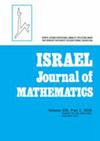厄尔多斯-莫泽尔和 IΣ2
IF 0.8
2区 数学
Q2 MATHEMATICS
引用次数: 0
摘要
已知拉姆齐定理的一阶部分对于任意颜色数的配对恰好是 BΣ03。我们将其与已知的拉姆齐配对定理分为较弱的原理,即 EM(厄尔多斯-莫泽原理)和 ADS(升序-降序原理)进行比较:我们证明,超出 IΣ02 的额外强度完全归因于 ADS 的任意颜色类似物。具体地说,我们证明任意颜色数的 ADS 意味着 BΣ03 ,而任意颜色数的 EM 对 IΣ02 是 Π11 保守的,它并不意味着 IΣ02。本文章由计算机程序翻译,如有差异,请以英文原文为准。
Erdős–Moser and IΣ2
The first-order part of Ramsey’s theorem for pairs with an arbitrary number of colors is known to be precisely BΣ 03 . We compare this to the known division of Ramsey’s theorem for pairs into the weaker principles, EM (the Erdős–Moser principle) and ADS (the ascending-descending sequence principle): we show that the additional strength beyond IΣ 02 is entirely due to the arbitrary color analog of ADS.
Specifically, we show that ADS for an arbitrary number of colors implies BΣ 03 while EM for an arbitrary number of colors is Π 11 -conservative over IΣ 02 and it does not imply IΣ 02 .
求助全文
通过发布文献求助,成功后即可免费获取论文全文。
去求助
来源期刊
CiteScore
1.70
自引率
10.00%
发文量
90
审稿时长
6 months
期刊介绍:
The Israel Journal of Mathematics is an international journal publishing high-quality original research papers in a wide spectrum of pure and applied mathematics. The prestigious interdisciplinary editorial board reflects the diversity of subjects covered in this journal, including set theory, model theory, algebra, group theory, number theory, analysis, functional analysis, ergodic theory, algebraic topology, geometry, combinatorics, theoretical computer science, mathematical physics, and applied mathematics.

 求助内容:
求助内容: 应助结果提醒方式:
应助结果提醒方式:


